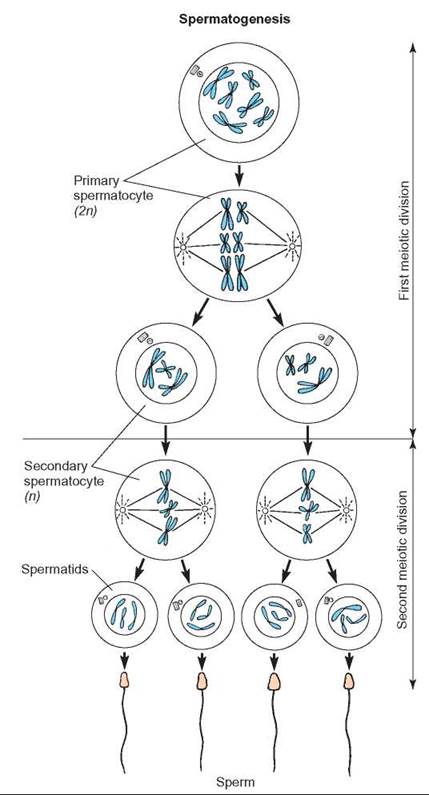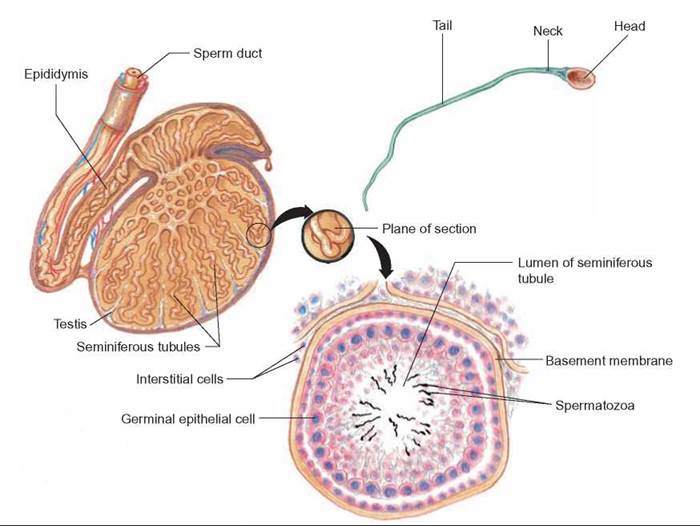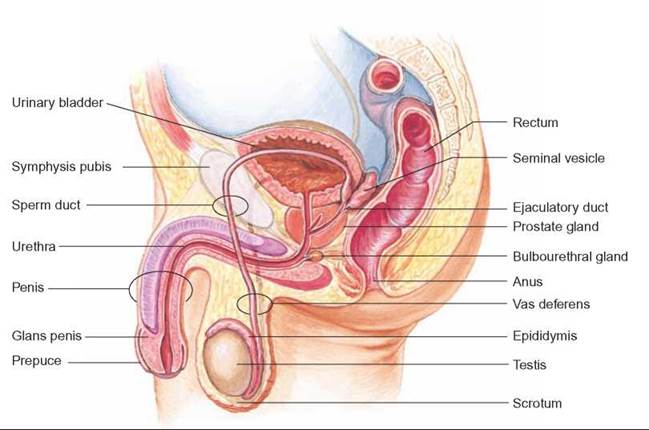CONCEPTS IN BIOLOGY
PART VI. PHYSIOLOGICAL PROCESSES
27. Human Reproduction, Sex, and Sexuality
27.6. Spermatogenesis
The process of producing gametes is called gametogenesis. It includes meiosis and other processes involved in producing mature sex cells. Spermatogenesis is gametogenesis that takes place in the testes of males, producing sperm (figure 27.9). The two, olive-shaped testes are composed of many small, sperm- producing tubes, called seminiferous tubules. The seminiferous tubules empty into collecting ducts that eventually empty into the epididymis—a long, narrow, twisted tube in which sperm cells are stored and mature before ejaculation. The testes and their associated ducts are held together by a thin covering membrane (figure 27.10). Leading from the epididymis is the vas deferens, or sperm duct; this empties into the urethra, which conducts the sperm out of the body through the penis (figure 27.11).

FIGURE 27.9. Spermatogenesis
This diagram illustrates the process of spermatogenesis in human males. Not all of the 46 chromosomes are shown. Carefully follow the chromosomes as they segregate, recalling the details of the process of meiosis.

FIGURE 27.10. Sperm Production
The testis consists of many tiny tubes called seminiferous tubules. The walls of the tubes consist of cells that continually divide, producing large numbers of sperm. The sperm leave the seminiferous tubules and enter the epididymis, where they are stored prior to ejaculation through the sperm duct. Sperm cells have a head region, with an enzyme-containing cap and the DNA. They also have a neck region, with ATP-generating mitochondria, and a tail flagellum, which propels the sperm.

FIGURE 27.11. The Human Male Reproductive System
The male reproductive system consists of two testes, which produce sperm; ducts, which carry the sperm; and various glands. Muscular contractions propel the sperm through the vas deferens past the seminal vesicles, prostate gland, and bulbourethral gland, where most of the liquid of the semen is added. The semen passes through the urethra of the penis to the outside of the body.
Before puberty, the seminiferous tubules are packed solid with diploid cells. These cells, which are found just inside the tubule wall, undergo mitosis, thus providing a continuous supply of cells. Beginning at puberty, some of these cells specialize and begin the process of meiosis, whereas others continue to divide by mitosis. Spermatogenesis needs to occur below body temperature, which is why the testicles are in a sac, the scrotum, outside the body cavity. Once spermatogenesis begins, the seminiferous tubules become hollow and can transport the mature sperm.
Spermatogenesis consists of several steps. It begins when some of the cells in the walls of the seminiferous tubules differentiate and enlarge. These diploid cells undergo the first meiotic division, which produces two haploid cells. These cells go through the second meiotic division, resulting in four haploid cells called spermatids. Spermatids then lose much of their cytoplasm, develop long tails, and mature into sperm. Sperm have only a small amount of food reserves. Therefore, once they are released and become active swimmers, they live no more than 72 hours. However, if the sperm are placed in a protective solution, the temperature can be lowered drastically to — 196°C. Under these conditions, the sperm become deactivated, freeze, and can survive for years outside the testes. This has led to the development of sperm banks. The artificial insemination (placing stored sperm into the reproductive tract of a female) of cattle, horses, and other domesticated animals with sperm from sperm banks is a common breeding practice. This technique is also used in humans who experience infertility.
Spermatogenesis takes place continuously throughout a male’s reproductive life, although the number of sperm produced decreases as a man ages. A healthy male releases about 150 million sperm per milliliter with each ejaculation. A man must be able to release at least 100 million sperm per milliliter to be fertile. Sperm counts can be taken and used to determine the probability of successful fertilization. Many men with sperm counts under 50 million per milliliter are infertile; those with sperm counts below 20 million per milliliter are clinically infertile. These vast numbers of sperm are necessary because so many die during their journey. Large numbers are needed in order for the few survivors to reach the egg. In addition, each sperm contains enzymes in its cap that are able to digest through the mucus and protein found in the female reproductive tract. Millions of sperm contribute in this way to the process of fertilization, but only one fertilizes the egg.
27.6. CONCEPT REVIEW
13. What structures are associated with the human male reproductive system? What are their functions?
14. How is meiosis involved in spermatogenesis?